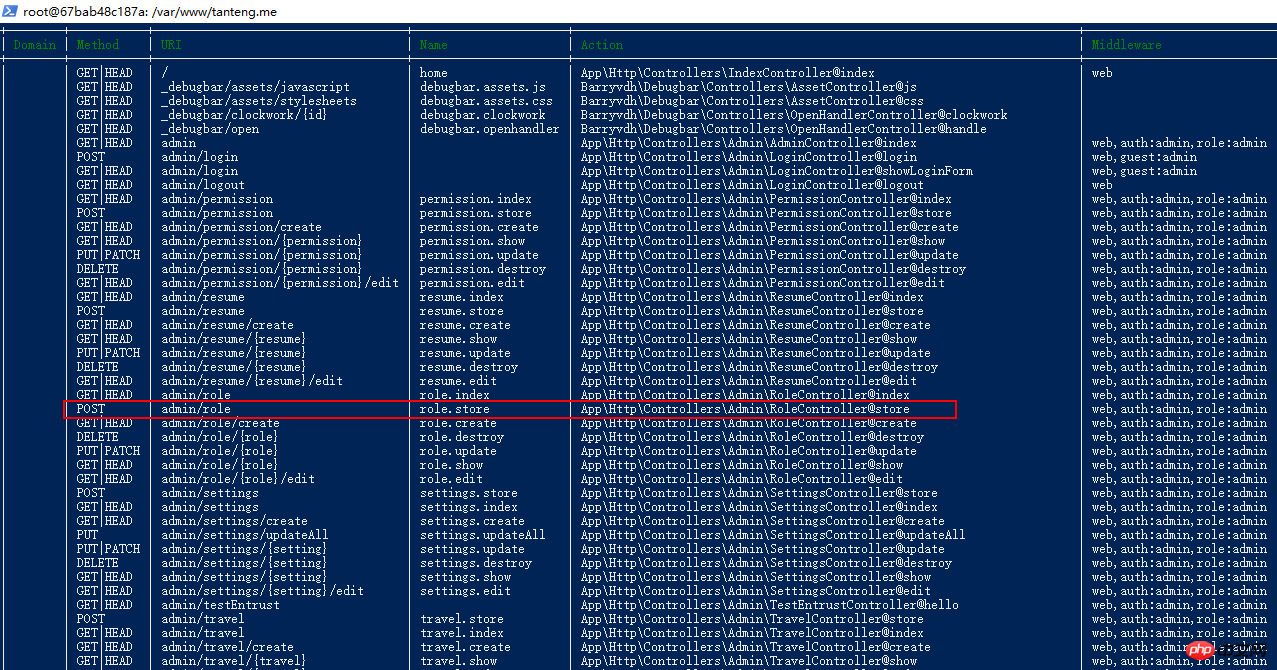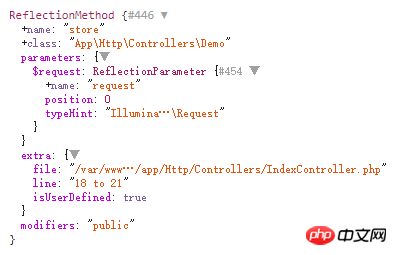 Backend Development
Backend Development
 PHP Tutorial
PHP Tutorial
 Parse Laravel dependency injection related content through source code
Parse Laravel dependency injection related content through source code
Parse Laravel dependency injection related content through source code
This article mainly introduces you to the relevant information on how to parse Laravel's dependency injection through source code. The article introduces it in great detail through sample code. It has certain reference learning value for everyone's study or work. Friends who need it can follow Let’s learn together with the editor.
Preface
As we all know, there are countless PHP frameworks. In recent years, a framework known for its elegance has gradually been known by domestic PHPers. , and started using it, but one obvious shortcoming of larave is that its documentation content is pitiful.
This article will give you a detailed introduction to Laravel dependency injection and share it for your reference and study. I won’t say much below, let’s take a look at the detailed introduction.
In the constructor or member method of Laravel's controller, dependency injection can be used through type constraints, such as:
public function store(Request $request)
{
//TODO
}Here, the $request parameter uses type constraints. Request is a class:\Illuminate\Http\Request, which means that the parameter must be this class or a subclass.
This article analyzes the source code of Laravel to see why Request can be used directly without passing in an instance in the method? It’s just that the framework automatically instantiates and passes parameters for us.
1. Route definition
Looking from the source, such a route is defined in the route definition file:
Route::resource('/role', 'Admin\RoleController');
This is a resource-based route. Laravel will automatically generate routing entries for additions, deletions, modifications and queries.

The store method at the beginning of this article is a controller method. The Action defined by the route visible in the figure is also: App\Http\Controllers\Admin\RoleController@store
Routing method analysis
Find the controller and method according to the routing definition, and execute the specific method in the dispatch method.
(File: vendor/laravel/framework/src/Illuminate/Routing/ControllerDispatcher.php)
public function dispatch(Route $route, $controller, $method)
{
$parameters = $this->resolveClassMethodDependencies(
$route->parametersWithoutNulls(), $controller, $method
);
if (method_exists($controller, 'callAction')) {
return $controller->callAction($method, $parameters);
}
return $controller->{$method}(...array_values($parameters));
}First resolveClassMethodDependencies method, "as the name suggests ” is to obtain the dependent object based on the method parameters of the class, and then call the class method and inject the object parameters.
If there are multiple dependent objects, they will be parsed out by foreach in turn and injected as parameters.
Code for obtaining dependent object examples:
protected function resolveClassMethodDependencies(array $parameters, $instance, $method)
{
if (! method_exists($instance, $method)) {
return $parameters;
}
return $this->resolveMethodDependencies(
$parameters, new ReflectionMethod($instance, $method)
);
}The key point here is the use of PHP reflection. Pay attention to the RelectionMethod method, which obtains the class Method parameter list, you can know the parameter type constraints, parameter names, etc.
The $instance parameter here is the RoleController controller class, and the $method parameter is the method name store.
2. Example of obtaining dependent objects
After obtaining the constraint type of the dependent object from the method parameters, you can instantiate the dependent object.
protected function transformDependency(ReflectionParameter $parameter, $parameters)
{
$class = $parameter->getClass();
// If the parameter has a type-hinted class, we will check to see if it is already in
// the list of parameters. If it is we will just skip it as it is probably a model
// binding and we do not want to mess with those; otherwise, we resolve it here.
if ($class && ! $this->alreadyInParameters($class->name, $parameters)) {
return $parameter->isDefaultValueAvailable()
? $parameter->getDefaultValue()
: $this->container->make($class->name);
}
}Get the object from the container based on the class name. The process of binding the object instance is first defined in the service provider.
Then pass the instantiated object into the store method, and you can use the dependent object.
3. About PHP reflection
Give an example of using ReflectionMethod.
class Demo
{
private $request;
public function store(Request $request)
{
}
}Print out the content of new ReflectionMethod(Demo::class, 'store') as shown in the figure:

You can get the parameter list of this method, the constraint type of the parameter, such as typeHint, Illuminate\Http\Request.
According to the class name, you can get the instance initially bound through the service provider from the container. .
Summary
Articles you may be interested in:
php data structure Examples of sequential linked lists and linked linear lists
Detailed explanation based on the difference between using commas and dots for echo in PHP
Example of php implementing statistical algorithm for counting the number of 1's in binary
The above is the detailed content of Parse Laravel dependency injection related content through source code. For more information, please follow other related articles on the PHP Chinese website!

Hot AI Tools

Undresser.AI Undress
AI-powered app for creating realistic nude photos

AI Clothes Remover
Online AI tool for removing clothes from photos.

Undress AI Tool
Undress images for free

Clothoff.io
AI clothes remover

Video Face Swap
Swap faces in any video effortlessly with our completely free AI face swap tool!

Hot Article

Hot Tools

Notepad++7.3.1
Easy-to-use and free code editor

SublimeText3 Chinese version
Chinese version, very easy to use

Zend Studio 13.0.1
Powerful PHP integrated development environment

Dreamweaver CS6
Visual web development tools

SublimeText3 Mac version
God-level code editing software (SublimeText3)

Hot Topics
 1386
1386
 52
52
 Laravel - Artisan Commands
Aug 27, 2024 am 10:51 AM
Laravel - Artisan Commands
Aug 27, 2024 am 10:51 AM
Laravel - Artisan Commands - Laravel 5.7 comes with new way of treating and testing new commands. It includes a new feature of testing artisan commands and the demonstration is mentioned below ?
 Laravel - Pagination Customizations
Aug 27, 2024 am 10:51 AM
Laravel - Pagination Customizations
Aug 27, 2024 am 10:51 AM
Laravel - Pagination Customizations - Laravel includes a feature of pagination which helps a user or a developer to include a pagination feature. Laravel paginator is integrated with the query builder and Eloquent ORM. The paginate method automatical
 How to get the return code when email sending fails in Laravel?
Apr 01, 2025 pm 02:45 PM
How to get the return code when email sending fails in Laravel?
Apr 01, 2025 pm 02:45 PM
Method for obtaining the return code when Laravel email sending fails. When using Laravel to develop applications, you often encounter situations where you need to send verification codes. And in reality...
 Laravel schedule task is not executed: What should I do if the task is not running after schedule: run command?
Mar 31, 2025 pm 11:24 PM
Laravel schedule task is not executed: What should I do if the task is not running after schedule: run command?
Mar 31, 2025 pm 11:24 PM
Laravel schedule task run unresponsive troubleshooting When using Laravel's schedule task scheduling, many developers will encounter this problem: schedule:run...
 In Laravel, how to deal with the situation where verification codes are failed to be sent by email?
Mar 31, 2025 pm 11:48 PM
In Laravel, how to deal with the situation where verification codes are failed to be sent by email?
Mar 31, 2025 pm 11:48 PM
The method of handling Laravel's email failure to send verification code is to use Laravel...
 How to implement the custom table function of clicking to add data in dcat admin?
Apr 01, 2025 am 07:09 AM
How to implement the custom table function of clicking to add data in dcat admin?
Apr 01, 2025 am 07:09 AM
How to implement the table function of custom click to add data in dcatadmin (laravel-admin) When using dcat...
 Explain the concept of Dependency Injection (DI) in PHP.
Apr 05, 2025 am 12:07 AM
Explain the concept of Dependency Injection (DI) in PHP.
Apr 05, 2025 am 12:07 AM
The core value of using dependency injection (DI) in PHP lies in the implementation of a loosely coupled system architecture. DI reduces direct dependencies between classes by providing dependencies externally, improving code testability and flexibility. When using DI, you can inject dependencies through constructors, set-point methods, or interfaces, and manage object lifecycles and dependencies in combination with IoC containers.
 Laravel - Dump Server
Aug 27, 2024 am 10:51 AM
Laravel - Dump Server
Aug 27, 2024 am 10:51 AM
Laravel - Dump Server - Laravel dump server comes with the version of Laravel 5.7. The previous versions do not include any dump server. Dump server will be a development dependency in laravel/laravel composer file.



